National, international and industrial projects
Industrial actions
Ph.D grants
Research grants
|
National actions
"Investissements d'avenir"
ANR National projects
|
|
FUI Project
DGA
OSEO Projects
|
International actions
European projects
Collaborations
|
Older projects (2000-2008)
Recent collaborations or projects
European Projects
FP7 Regpot Across
|
FP7 Regpot Across: this 42-month project started in September 2011.
It is a network entitled ``Center of Research Excellence for Advanced Cooperative Systems'' managed by Prof. Ivan Petrovic from University of Zagreb (Croatia). It involves many european partners: KTH (Sweden), ETHZ (Switzerland), TUM (Germany), University of Manchester (UK), Vienna University of Technology (Austrtia), Politecnico di Milano (Italy), University of Sevilla (Spain), Eindhoven University of Technology (The Netherlands), University of Athens (Greece), etc.
It provides grants for scientific visits and internships: three master
students from the University of Zagreb came in Rennes for four months in 2012,
and one Ph.D. student will come for three months in 2013.
|
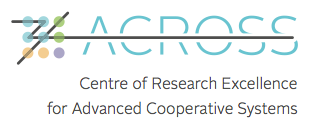
|
Pegase project - FP6 Aerospace
|
This FP6 project started in September 2006. It is managed by Dassault
Aviation and groups many industrial and academic partners (Alenia Aeronautica,
Eurocopter, EADS, Walphot, I3S, EPFL, ETHZ, IST, JSI). It is concerned with
the automatic
landing of fixed wing aircrafts and helicopters using a vision sensor.
In this project, we are the leader
of the workpackage devoted to visual tracking and visual servoing.
Pegase www site
|

|
International collaborations
STIC Amsud
|
This 2-year project ended fall 2011. It was a collaboration
with the computer science center of Federal University of Pernambuco in
Recife, Brazil, and with the Robotics and Automation Dpt., Mining Technology
Center at the Universidad de Chile in Santiago. The collaboration with
Santiago de Chile allowed
François Chaumette to participate to the 5th IEEE Latin American Summer School on Robotics in December 2011, and to the IEEE RAS Summer School on Robot
Vision and Applications in December 2012. The collaboration with Recife was
about augmented reality [Lima13a][Lima12a][Lima12b][Lima12c].
|
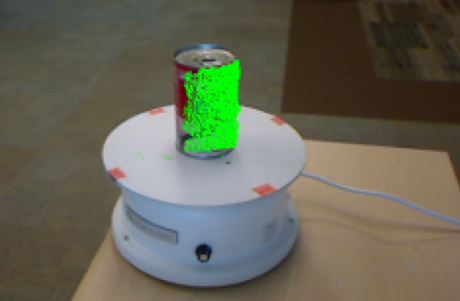
|
"Investissements d'avenir"
Equipex Robotex
|
Equipex Robotex: this 10-year project managed by CNRS started fall 2011. Lagadic is one of the 15 French partners involved in this network. It is devoted to get significative equipments in the main robotics labs in France. Up to now, it allowed us to get a Viper S650 arm and a Pioneer 3DX. Our
main equipment, the humanoid robot Romeo by Aldebaran Robotics, will be
delivered in June~2013. Robotex also allowed us to enlist Aurélien Yol as an
engineer for one year in 2012. Aurélien worked to add functionalities in ViSP
requested by the Robotex partners (mainly Laas and Isir).
|

|
ANR/FUI national projects
ANR P2N Nanorobust
|
This 4-year project started at the beginning of 2012. It involves
Femto-ST (prime) in Besançon, LPN and Isir in Paris, Thalès and
Lagadic group through the Université de Rennes 1. Nanorobust deals
with the development of nano-manipulation within SEM (Scanning
Electron Microscope). Our goal is to provide visual servoing
techniques for positioning and manipulation tasks with a nanometer
accuracy.
|

|
FUI Rev-TV
|
This 33-month project ended fall 2012. It was composed
of a consortium managed by Technicolor with Artefacto, Istia,
Soniris, Bilboquet companies, Télécom Bretagne, and Inria Metiss and Lagadic groups, all located in Rennes.
The goal of this project was to provide tools to
develop new TV programs allowing the final user to interact within an
immersive and convivial interface.
Within this project, we developed visual tracking and servoing algorithms for
3D camera localization. Our works on RGB-D sensor have been realized in the
scope of this project.
www: http://www.rev-tv.eu
|

|
ANR Contint Prosit project
This project is a multidisciplinary industrial research type project led by the Prisme lab (previously called LVR) in Bourges. It is just starting in collaboration with Lirmm in Montpellier, LMS in Poitiers, CHU of Tours, and the Robosoft company. The object of this project is to develop an interactive master-slave robotic platform for a medical diagnosis application (tele-echography) and to develop a cluster of interactive functionalities combining: visual servoing, force control, haptic feedback, virtual human interface, 3D representation of organs. Within this project, we will study and develop autonomous control modes that directly make use of visual data provided by a camera observing the patient and information contained in the ultrasound image to move the ultrasound probe.
|
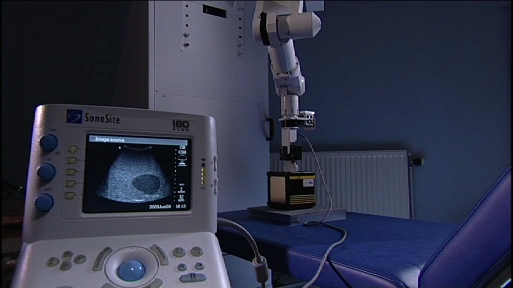
|
ANR Contint USComp project
This project, led by Alexandre Krupa, has just started. It involves a collaboration with the Visages team in Rennes, LSIIT in Strasbourg and Lirmm in
Montpellier.
Its goal is to provide methodological solutions for real-time compensation of soft tissues motion during ultrasound imaging.
The approach will consist in synchronizing the displacement of a 2D or 3D ultrasound transducer to stabilize the observed image by the use of a robotic arm actuating the ultrasound probe. The problematic concerns more specifically the use in the control scheme of the peroperative ultrasound image, the interaction force between the probe and the soft tissues and the measurements of external signals providing the breathing state of the patient.
|

|
ANR Psirob RobM@rket project
This project started in March 2008. It is realized in collaboration
with BA Systèmes, CEA List, and Université de Caen. RobM@rket project aims
at developing automated applications for order picking in a
fast-expanding business which mainly includes manual tasks. The system
would apply to packaging before dispatching items ordered on a website
through an online catalogue including more than 1000 references or to
order picking with orders dedicated to kitting.
The robotic system will be made of a PLC mobile platform of AGV type
(Automatic Guided Vehicles, by BA Systèmes) and of an industrial robot
arm. This platform will be used to integrate several algorithms allowing
picking up selected items in a warehouse through a command file and
bringing them back for dispatching or assembling them. The items could
be either methodically stored or jumbled in the boxes. Our current work
consists in developing vision-based objects localization techniques for
grasping them.
|

|
ANR Tosa CityVIP project
ANR Tosa CityVIP: this 42-month project ended at the end of 2011. It
involved Lasmea (prime) in Clermont-Ferrand, Inria (Lagadic and ARobAS), Heudiasyc in Compiègne, LCPC in Nantes, IGN in Paris, XLim in Limoges, and Benomad company in Nice.
The project consisted of enhancing the
autonomy of urban vehicles by integrating sensor-based techniques with a
geographical database. Our works about navigation using a visual memory and
obstacles avoidance have been realized in the scope of this project
ANR AM Gamme project
This project started in March 2008. It is realized in collaboration
with Orange Labs, CEA Leti, Movea, Polymorph, and the
Museum of fine arts in Rennes.
The Augmented Reality (AR) concept aims to enhance our real world
perception, combining it with fictitious elements. AR research is
concerned with the different methods used to augment live video
imagery with coherent computer generated graphics.
The combination of mobile technologies and AR will allow the design of
a video rendering system with an augmentation of the real world
depending on user localisation and orientation.
In this project we propose to focus on indoor environments having as
a main objective the implementation of AR technologies on mobile
devices. The experimental field proposed is the Museum, a
controlled environment (constant lightening and location of objects)
without some of the perturbations of outdoor environments. We do
estimate that a successful museum prototype could be used as the
backbone of many other indoor and outdoor AR applications.
Within this project we are involved in tracking and sensor fusion
parts of the AR process.
|
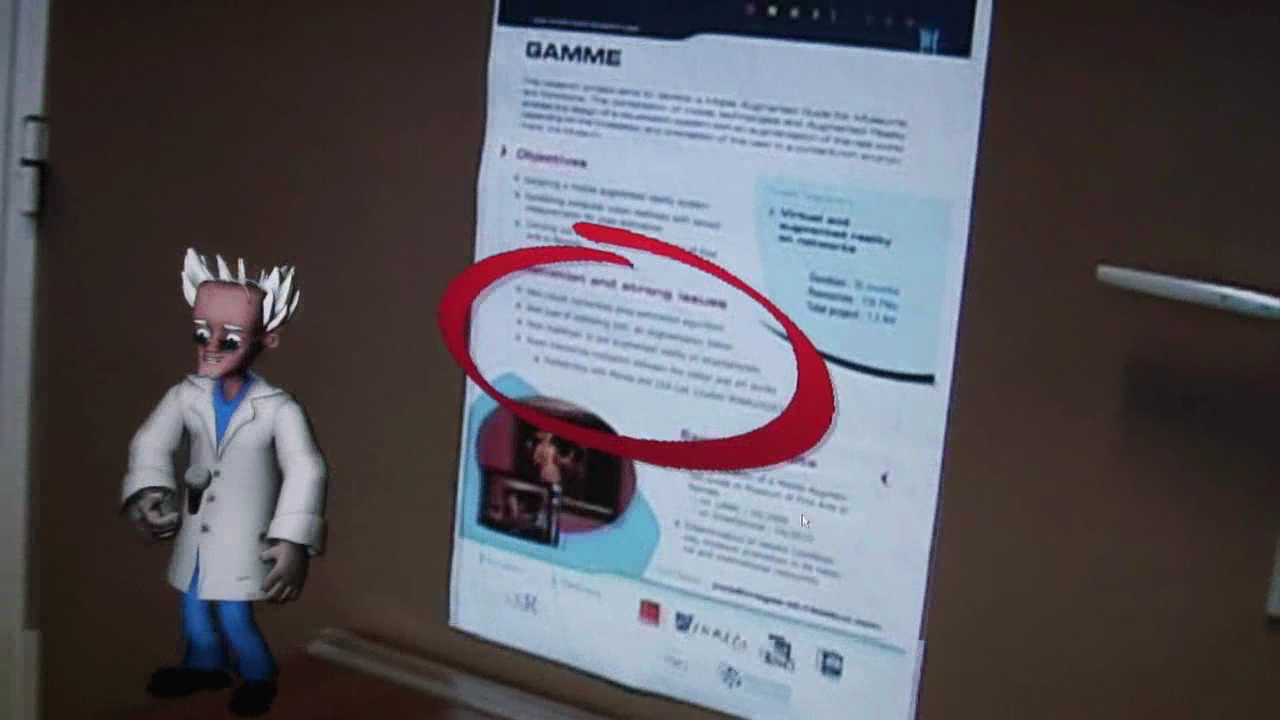
|
ANR Psirob Scuav project
This project, led by Tarek Hamel from I3S, started in June 2007.
It is realized in collaboration with I3S, the EPI ARobAS at Inria
Sophia Antipolis-Méditerranée, Heudiasyc in Compiègne,
the CEA-List and the Bertin company. It is devoted to the sensor-based
control of small helicopters for various applications (stabilization
landing, target tracking, etc.).
DGA project
PEA DGA DECSA
|
PEA Decsa: this 3-year project funded by DGA started fall 2011. It is
composed of a consortium managed by Astrium in Toulouse with the Novadem,
Sirehna, Spot Image and Magellium companies, and with Inria
Steep group in Grenoble and Lagadic. It is devoted to the development of navigation and perception algorithms for small drones in urban environment.
|

|
OSEO
OSEO Romeo 2
|
This four-year project started in December 2012. It is a huge
project lead by Aldebaran Robotics to develop functionalities
on the new humanoid robot Romeo. Our work in this project is
devoted to develop vision-based navigation and manipulation tasks.
|
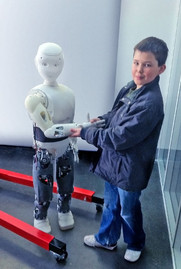
|
OSEO Apash
|
Oseo Apash: this 2-year project started in September 2012. It is
managed by Marie Babel from Lagadic and involves three laboratories connected
to Insa Rennes, namely Irisa/Inria, IETR and LGCGM, and two industrial partners: AdvanSEE in Nantes and Ergovie in Rennes. It aims at designing a driving assistance for electrical wheelchair towards the autonomy and security of disabled people.
|
|
Industrial projects
Astrium
|
Astrium 2010: this 6-month contract was devoted to test our MBT
for autonomous satellites rendezvous. It has been very succesful [Petit11b][Petit11a], which allowed us to start a fruitful collaboration with Astrium (Antoine Petit and Tawsif Gokhool's Ph.D., PEA Decsa).
|
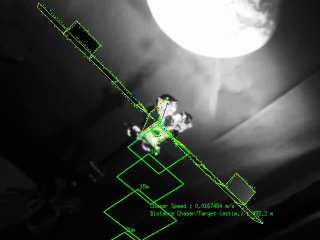
|
Orange-Labs
|
Orange-Labs: this 3-year contract will end in March 2013. It supports
the Cifre convention between Orange Labs and Université de Rennes 1
regarding Pierre Martin's Ph.D about augmented reality on mobile devices.
|

|
Dassault Aviation
|
Dassault Aviation: this 3-year contract ended fall 2012. It supported the
Inria-DGA grant for Laurent Coutard's Ph.D. about autonomous landing on aircraft carrier.
|

|
Fondation de recherche EADS
|
This contract that started in March 2011 supports Antoine Petit's Ph.D. about 3D model-based tracking for applications in space (satelitte servincing, rendezvous, debris removal,...).
|
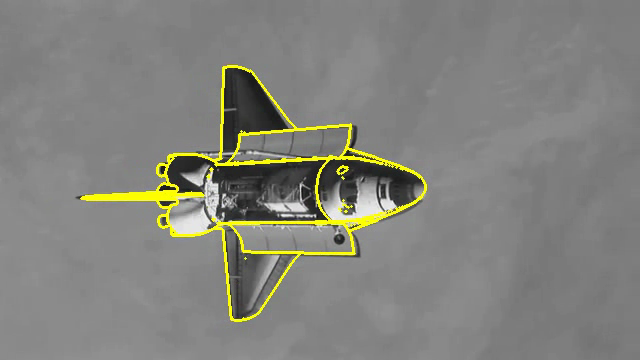
|
Astrium
|
Astrium 2012-2015: this 3-year contract started in February 2012. It
supports Tawsif Gokhool's Ph.D. about visual mapping of complex 3D
environments that evolve over time, in the scope of the recent general convention between Astrium and Inria.
|

|
ECA Robotics
|
ECA Robotics: this 3-year contract started in May 2012. It
supports the Cifre convention between ECA Robotics and Inria Sophia Antipolis
regarding Romain Drouilly's Ph.D. about specifying a semantic representation well adapted to the problem of navigation in structured indoor or outdoor
environments.
|
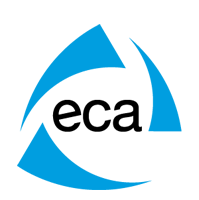
|
Past collaborations or projects
Industrial actions
Ph.D grants
Research grants
|
National actions
ANR National projects
DGA
ARC INRIA
|
International actions
European projects
Collaborations
|
European projects
European Space Agency - Vimanco: Vision-based manipulation of
non-cooperative objects
|
We began in october 2005 a project for the European Space Agency. It will be
realized in collaboration with the Trasys company (Brussels), Galileo
Avionica (Milano) and KUL in Leuven. Its aims is to develop a demonstrator
able to grasp objects using vision-based control of robot in space
environment. The considered robot is the ESA Eurobot prototype. Our task in this project
is to provide algorithms for objects tracking and vision-based control.
Vimanco www site
|

|
International collaborations
EA Talisker, France-US
|
Lagadic is involved in an Inria associate team (EA) with Prof. Seth Hutchinson
from Beckman Institute at the University of Illinois at Urbana-Champaign (UIUC).
In the scope of this project, Seth Hutchinson has spent a one-week visit
in March, September and November 2008.
Reciprocally, Mohammed Marey and François Chaumette have spent
a one-week visit at
Beckman Institute in May and November 2008 respectively. Roméo Tatsambon Fomena
has spent a one-month visit in August 2008 to work on the visual servoing
of a mobile robot using an omnidirectional vision sensor
|

|
CNRS PICS, France-Australia
This international collaboration between France and Australia is supported
by CNRS. It is about visual servo-control of unmanned aerial vehicles. It
started fall 2005 for three years. It joins Rob Mahony (Australian
National University, Canbera), Peter Corke and Jonathan Roberts (CSIRO,
Melbourne), Tarek Hamel (I3S, Sophia-Antipolis), Vincent Moreau (CEA-List,
Paris) and our group.
INRIA/GRICES project, France-Portugal
This collaboration with IST Lisbon, Portugal (Prof. J. Santos-Victor) is
concerned with visual servoing for robotics applications. M. Lopes did a
one month visit in our group in February 2005, and N. Mansard did a one
month visit at IST in June 2005.
ANR projects
Predit Mobivip project
This project is a large project headed by Inria
Sophia Antipolis. It is concerned with the navigation of mobile vehicles in
urban environments. Within this project, our work consists in designing
autonomous vision-based navigation techniques using an image database of
the environment. As for scientific aspects, this project is
closely related to the Robea Bodega project.
Sora RIAM Project (2003-2005)
|
The goal of the SORA project (Objects tracking for augmented reality) is the
developpement of tracking algorithm for augmented reality application. Our
partners are Total-Immersion and VideoMage. Augmented Reality has now
progressed to the point where real-time applications are being considered and
needed. At the same time it is important that synthetic elements are rendered
and aligned in the scene in an accurate and visually acceptable way. In order
to address these issues a real-time, robust and efficient 3D model-based
tracking algorithm is proposed for a 'video see through' monocular vision
system. Virtual objects can then be projected into the scene using the pose.
The tracking rate is 50Hz.
|
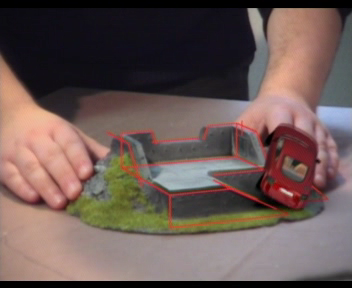
|
DGA project
PEA Tarot
|
This project is a large project realized for the DGA through a
consortium led by Thales Optronics. We work in close collaboration
with the ARobAS team at Inria Sophia Antipolis-Méditerranée.
This project
is about the development of tracking algorithms and the control of
non-holonomic vehicles. Within this project, our work consists in
developing 2D image-based tracking algorithms in complex outdoor
scenes. The algorithms provided last year using points of interest
were improved, new
functionalities were added and our contribution was ported to the DGA's
autonomous military terrestrial vehicle dedicated to survey
missions.
|

|
Industrial collaborations and transfers
CEA List: Clickrog: Object grasping for disable persons
This contract started in November 2005. It is also supported by the Brittany
Council through a grant to Claire Dune for her PhD (``krog'' means grasping
in the Breton language).
It is dedicated to object manipulation
by visual servoing. The goal of this project is to allow
disable persons to grasp an object with the help of a robotic arm mounted on a
wheel chair. This task should be achieved with a minimum of a priori
information regarding the environment, the considered object, etc.
|
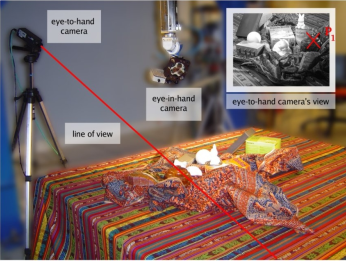
|
France Telecom R&D: Cifre convention
This contract is devoted to support the Cifre convention between France
Telecom R&D and Inria regarding Fabien Servant's Ph.D. The goal of the
Ph.D. is to enable augmented reality on mobile devices like GSM or
PDA used by pedestrians in urban environments.
More precisely, its aim is to
compute the absolute pose of the camera to show to the end-user
geolocalized information in an explicit way.
France Telecom R&D: Augmented reality in urban environment
This contract started in October 2005.
Considering the algorithm Markeless, the goal of this
project is to evaluate its capability to handle rough models provided by
geographic information systems. A second part of this project will consider the
automatic initialization of the tracking process.
Total Immersion
|
The Marker software implements an algorithm allowing the computation of
camera attitude the calibration of the cameras using fiducial markers. Pose
computation is handling using the virtual visual servoing approach. The idea
consists in regarding the pose and the calibration as the dual problem of
visual control. This method presents many avantages: precision identical to
the traditional non-linear minimization methods, simplicity, effectiveness.
Licence: A licence of this software was yielded to the company Total Immersion.
Demonstration:: Virtual Visual Servoing: A framework for augmented reality
|

|
Cemagref-Ofival grant
Quality evaluation of porc meat
|
This study relates to the evaluation of the quality of sides of meat of pig by
active vision and IRM measurements. It follows upon a joint proposal of
CEMAGREF Rennes, Olympig company and Vista project at Ofival which agreed to
give a financial support. Within this project, our task deals with a
vision-absed estimation of the volume of piece of ham. This is join project
with Cemagref for the ofival. We proposed algorithms for 3D reconstruction and
exploration of a scene using a mobile and controlled camera. We used a space
carving algorithm to obtain a precise and robust reconstruction of the 3D
structure of unknown objects. To ensure the complete reconstruction of all the
objects of the scene we present a gaze planning strategy that mainly uses a
representation of known and unknown areas as a basis for selecting new
viewpoints. The trajectory that leads to this exploration is handled using a
visual servoing approach.
|
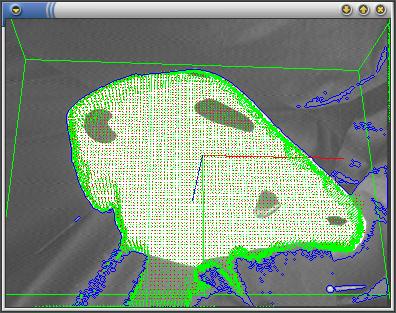
|
Ifremer
Dynamic stabilization of a pan and tilt camera for sub-marine image visualization
| One major problem of under-water observation with an automatic engine is
the instability of image acquiring. Indeed, this kind of small engines are
submitted to low-frequency motions due to weak friction and currents of
water. In this study, we proposed to maintain stabilization in the image by
controlling the pan and tilt motions of the camera mounted inside the engine,
using techniques applied for target tracking. The main idea within this
approach lies in the fact that, as it is very difficult to track a point of an
unknown scene using geometrical tools, it can be retrieved by the integration
of its speed. Indeed, the velocity in the image can now be estimated in
real-time, and without any a priori knowledge of the image content. Our approach has been validated on a dry set-up.
|
 |
Controlling an uninstrumented manipulator by visual servoing
| In this study, we proposed a method to control the displacement of a robot
arm (the Victor 6000) with no proprioceptive sensor. The joint positions are
not available and this manipulator is usually open-loop controlled. In order to
get a more efficient control interface, we propose a closed-loop system based
on an eye-to-hand visual servoing approach. We show that, using such an
approach, measurement of the manipulator motion with proprioceptive sensors is
not required to precisely control the end-effector motion. We propose solutions
for position-based control and velocity control of the manipulator. To maintain
the end effector in the camera field of view, the camera orientation is also
controlled.
|
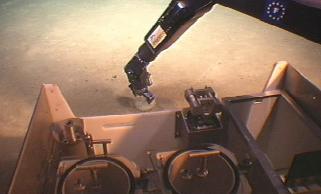 |
CNRS ROBEA Projects
Parknav project
This three years project, which began in october 2002 and financed by CNRS
within the ROBEA framework is a collaboration between INRIA Grenoble (Sharp,
Movi, PRIMA), the LAAS (RIA) and the VISTA project. The objective of this
project is the automation of the control of a vehicle in road environment.
Omnibot project
This two years project started in October 2002. The aim of this project
is to develop robot navigation schemes using a panoramic vision sensor.
It is realized through a collaboration between Lasmea in Clermont-Ferrand,
Lirmm in Montpellier, Crea in Amiens and our group. This year, we
have determined the analytical form of the interaction matrix related to
image moments using the very particular geometrical models of panoramic
sensors. A visual servoing control law has then been developed from this
modeling step. A project meeting has been organized at Irisa in
November 2003.
Tasks sequencing project
This three years project started in September 2003. The aim of this project
is to develop tasks sequencing schemes to realize high level robotics
tasks from local sensor-based control techniques. Comparison between
vision-based control and human beings for gaze control is also considered.
It is realized through a collaboration between Laas, Cerco and Enit, all
located in Toulouse, and our group.
Bodega project
This two years project started in November 2003. Its aims is to develop
vision-based and sensor-based methods for the autonomous navigation of
mobile vehicles moving around an urban environments.
It is realized through a collaboration between Ensil in Limoges,
UTC in Compiègne, Lasmea in Clermont-Ferrand, the Icare group of Inria
Sophia-Antipolis, and our group.
A project meeting has been organized at Irisa in November 2003.
Robvolint project
This two years project started in November 2003. Its aims is to develop
vision-based localization techniques and visual servoing schemes for
small helicopters moving around an indoor environment. It is realized
through a collaboration between I3S in Nice, Cea in Fontenay-aux-Roses,
and our group.


























